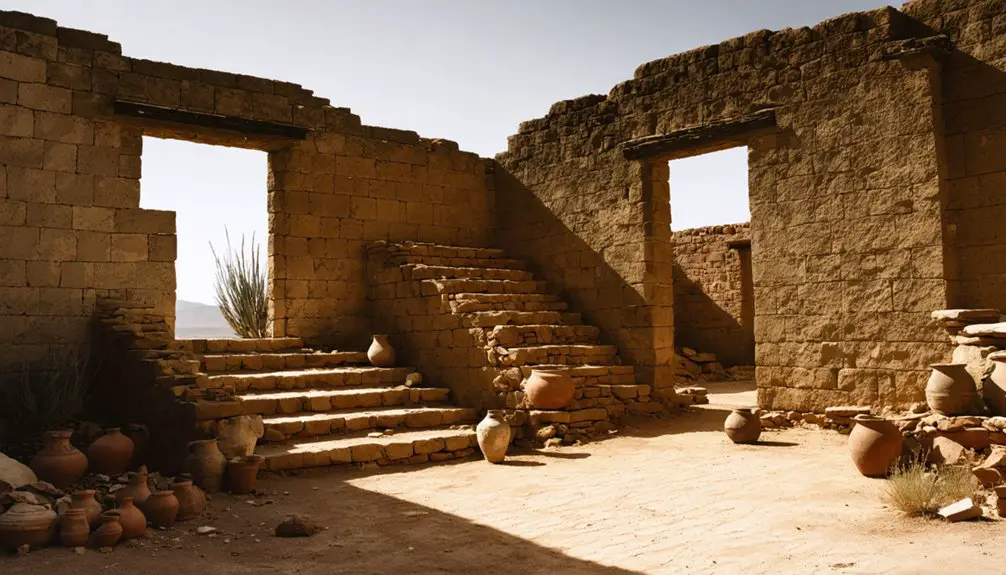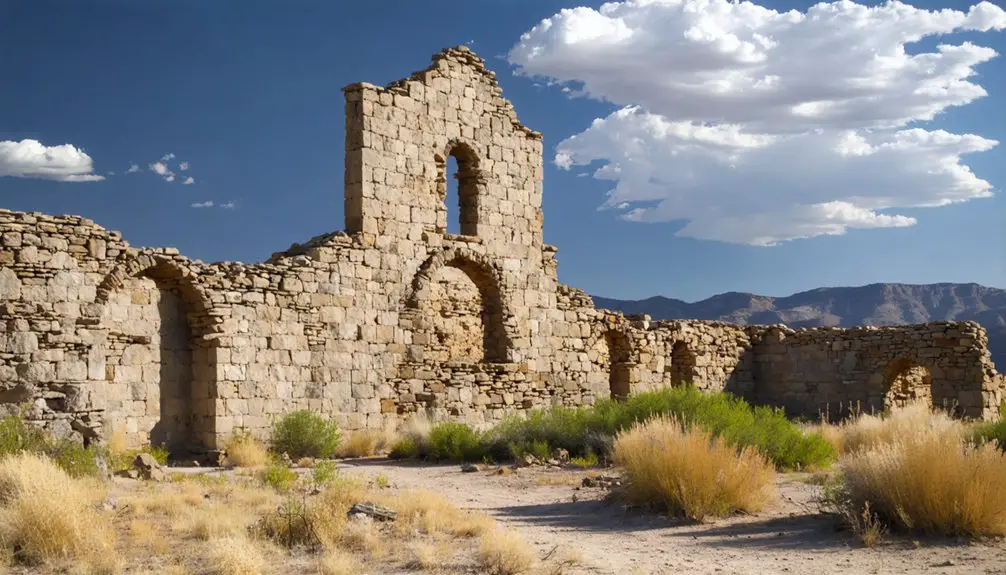You’ll find Gran Quivira’s haunting ruins in central New Mexico, where two massive 17th-century Spanish mission churches stand sentinel over an ancient Pueblo trade center. The site’s limestone walls and hidden kivas tell a complex story of cultural transformation, from its origins as a thriving Native American settlement to its final days in 1679. Archaeological evidence reveals a sophisticated community of up to 2,000 residents who mastered salt trading and textile production. The site’s artifacts continue to uncover layers of fascinating historical secrets.
Key Takeaways
- Gran Quivira was abandoned in 1679 after drought, famine, and Apache raids devastated the once-thriving pueblo community of 2,000 residents.
- The ghost town features impressive ruins of two mission churches, San Isidro and San Buenaventura, built by Spanish missionaries in the 1600s.
- Archaeological remains include over 200 limestone pueblo rooms arranged in concentric circles, showcasing the settlement’s sophisticated architecture.
- The site is now preserved as part of Salinas Pueblo Missions National Monument, with a visitor center and interpretive trail.
- Before its abandonment, Gran Quivira served as a major trading center connecting the Great Plains, Pacific Coast, and Great Basin regions.
The Rise of a Major Pueblo Trading Hub
Although Gran Quivira began modestly with pithouses around 800 A.D., it evolved into one of the Southwest’s most significant trading centers by 1300.
You’ll find evidence of the Tompiro people’s ingenuity in establishing extensive trade networks that connected the Great Plains, Pacific Coast, and Great Basin regions.
Despite the harsh, arid environment, the pueblo thrived through strategic resource extraction, particularly salt mining. The community depended heavily on summer monsoon rains for their agricultural survival.
You can trace their resourcefulness through the deep wells they dug seven miles west, ensuring water security for up to 2,000 residents.
The pueblo’s artifacts reveal a sophisticated economy based on salt trade, textiles, and buffalo products.
Within the 226-room complex beneath Mound 7, you’ll discover how Gran Quivira’s residents mastered both architectural innovation and economic diversification, making it the largest and most influential of the Salinas pueblos.
Situated at an elevation of 6500 feet, the settlement offered strategic advantages for both defense and trade operations.
Spanish Missionaries and Cultural Transformation
When Don Juan de Oñate arrived in 1598, he set in motion a transformative period at Gran Quivira that would forever alter the Tompiro way of life.
Under Spanish missionary influence, the pueblo saw the construction of two major churches – San Isidro in 1635 and San Buenaventura in 1659, both built with forced indigenous labor. The Tompiro were skilled at mining local salt, which became a valuable trading resource under Spanish control. The missionaries introduced new agricultural products to attract and maintain the local population.
Spanish missionaries directed the construction of San Isidro and San Buenaventura churches using coerced native labor at Gran Quivira pueblo.
The cultural assimilation was calculated and systematic. While missionaries initially tolerated traditional practices, by the 1660s they’d intensified their control, demanding the Tompiro people abandon their ancestral beliefs.
You can still see evidence of resistance in the hidden kivas discovered within mission walls. The Spanish imposed strict labor demands and resource quotas, disrupting traditional economies and social structures.
This cultural transformation ultimately contributed to Gran Quivira’s downfall, as drought, famine, and Apache raids drove the remaining inhabitants to flee by 1679.
Ancient Architecture and Building Techniques
Since its humble beginnings before 600 AD, Gran Quivira’s architecture evolved from simple pit houses and jacales into sophisticated limestone pueblos that showcased the inhabitants’ masterful building techniques.
You’ll find evidence of their ingenuity in the early circular pueblo’s construction, where they used ancient materials like blue-gray limestone held together with yellow caliche mortar.
Around 1550, they transformed their architectural style, adopting a rectangular grid pattern that accommodated about 250 rooms. The massive stone walls reached heights of 28-30 feet in the churches. They supported their roofs with wooden vigas and possibly parallel post rows.
Their construction techniques adapted perfectly to the harsh environment. They quarried local limestone, produced lime-based mortars, and built strategic water catchment systems on hillsides.
These architectural choices reflected their understanding of resource management and environmental challenges in this arid region. The buildings incorporated unique design elements like room blocks facing south to maximize sunlight exposure throughout the day.
Hidden Kivas and Religious Resistance
You’ll find archaeological evidence of hidden kivas ingeniously tucked within Gran Quivira’s pueblo walls, where indigenous people maintained their sacred ceremonies despite Spanish efforts to suppress native religious practices.
These concealed prayer chambers, discovered during excavations beneath and alongside mission structures, reveal how Pueblo inhabitants actively resisted colonial domination while outwardly appearing to conform to Catholic conversion.
The strategic placement of these secret ceremonial spaces, adapted from existing rooms within Las Humanas pueblo, demonstrates the resourcefulness and determination of native peoples to preserve their spiritual traditions during the turbulent 17th century.
The Apache raids in 1670 devastated much of the remaining indigenous resistance and ceremonial practices at the site.
Visitors can explore evidence of this cultural resilience across 611 acres of the sprawling ancient city, where both native and colonial structures stand as testament to this complex period of history.
Secret Prayer Beneath Stone
Deep within the stone walls of Gran Quivira, hidden kivas tell a compelling story of religious resistance and cultural preservation.
You’ll find these secret chambers embedded in the pueblo’s masonry, where indigenous people maintained their spiritual practices despite Spanish oversight. The Jumanos transformed rectangular rooms in Mound 7 into concealed prayer spaces, demonstrating remarkable spiritual concealment beneath the watchful eyes of Franciscan missionaries.
As you explore the hilltop ruins, you’ll discover how native worshippers adapted their sacred spaces, building underground chambers and modifying existing rooms.
This indigenous persistence flourished even as the Spanish Inquisition intensified its presence at nearby Quarai. While the mission church of San Buenaventura dominated the skyline, these hidden kivas preserved ancient traditions until the pueblo’s final abandonment.
Native Rituals Persisted Underground
While Spanish missionaries sought to suppress indigenous religious practices, archaeological evidence reveals how Gran Quivira’s Jumano people maintained their spiritual traditions through hidden kivas beneath the pueblo’s surface.
You’ll find ingenious kiva adaptations in converted rectangular rooms within Mound 7, where the Jumanos created underground chambers using salvaged mission materials and limestone blocks.
These secret spaces preserved essential ritual symbolism, as proven by discoveries of ceremonial objects like bison head masks and significant quantities of bird remains.
The builders cleverly positioned these kivas beneath convento patios and corrals where Spanish oversight was minimal. Ventilator shafts were modified for prolonged concealment, and the strategic placement within the pueblo’s grid architecture allowed native ceremonies to continue undetected until the settlement’s abandonment in 1672.
The Final Years and Mass Exodus

During the late 17th century, Gran Quivira experienced a catastrophic decline that would ultimately lead to its complete abandonment. When Apache raiders attacked in September 1670, they killed 11 residents and captured 30 others, triggering a mass migration that devastated the once-thriving pueblo.
You’ll find evidence of this community decline in the archaeological record, as the population plummeted from 10,000 to merely 500 by 1672. What was once a significant trade center that housed up to 2,000 residents became a shadow of its former self.
The final years were marked by impossible choices. Despite their established agricultural success and stone dwellings, the remaining inhabitants couldn’t withstand the combined pressures of raids, religious tensions, and dwindling resources. European diseases swept through the community, further accelerating the pueblo’s demise.
Archaeological Discoveries and Preservation
Archaeological investigations at Gran Quivira began long after its inhabitants’ departure, starting with Adolph Bandelier’s groundbreaking survey in 1883. Through advanced archaeological techniques, researchers uncovered a rich timeline of human occupation dating back to 600 AD, revealing the shift from pit houses to sophisticated pueblo structures built with distinctive yellow caliche mortar.
You’ll find evidence of the site’s remarkable evolution in the excavated ruins, where over 200 rooms arranged in concentric circles tell the story of a thriving trade hub.
The National Park Service’s preservation efforts since 1951 have tackled significant preservation challenges, stabilizing ancient structures like the San Isidro church and protecting the site’s cultural heritage.
Today, as part of the Salinas Pueblo Missions National Monument, Gran Quivira’s 1,071 acres continue to yield insights into the lives of its former inhabitants.
Visiting the Sacred Ruins Today
How can you best experience the remarkable ruins of Gran Quivira today? Start your journey at the visitor center near the parking area, where you’ll find exhibits showcasing authentic tools and artifacts from the Las Humanas Pueblo inhabitants.
From there, take the half-mile interpretive trail that winds through the ancient limestone structures, including the impressive San Buenaventura and San Isidro mission churches.
You’ll discover Mound 7, the largest pueblo site, perched at the highest point of Gran Quivira. Here, you can explore the architectural remnants while taking in panoramic views of New Mexico’s high desert landscape.
The site’s interpretive signs and ranger-led tours reveal the fascinating story of this cultural crossroads where Pueblo and Plains peoples once traded and lived together.
Frequently Asked Questions
What Wildlife Can Visitors Commonly Encounter at Gran Quivira Today?
Like a desert symphony, you’ll spot abundant wildlife ideal for photography, including Steller’s Jays, coyotes, deer, and elk. Your bird watching adventures might reveal Northern Waterthrush among 150 different species.
Are There Any Reported Paranormal Activities or Ghost Sightings at the Ruins?
You’ll find documented ghost sightings of mysterious lights near windows, with paranormal investigations reporting unexplained glows and reflections. Local ghost tours frequently explore these claims at the historic ruins.
What Items Were Traded at Gran Quivira During Its Peak Trading Period?
You’ll find evidence of rich historical commerce centered on buffalo products, salt, pottery, turquoise, and woven textiles. Trade goods also included agricultural items, animal skins, and later, Spanish-introduced metal tools.
How Deep Were the Original Pit Houses Dug Into the Ground?
Archaeological discoveries show pit houses from 800 AD were dug 3-6 feet into rocky ground. You’ll find these prehistoric architectural shelters matched their width, letting inhabitants adapt freely to harsh seasonal conditions.
What Traditional Ceremonies Are Still Performed by Descendants at Gran Quivira?
You’ll find descendants performing ceremonial dances honoring ancestral spirits and seasonal cycles, though they keep most traditional rituals private to protect their sacred cultural practices from outside observation.
References
- https://newmexiconomad.com/salinas-pueblo-missions/
- https://en.wikipedia.org/wiki/Las_Humanas
- https://oneforthemoneytwofortheroad.com/2023/03/26/new-mexicos-salinas-pueblo-missions/
- https://www.placesthatwere.com/2015/12/awesome-ruins-of-salinas-pueblo.html
- https://npshistory.com/publications/sapu/brochures/1966.pdf
- https://newmexiconomad.com/gran-quivera-missions/
- https://en.wikipedia.org/wiki/Salinas_Pueblo_Missions_National_Monument
- https://www.legendsofamerica.com/gran-quivira-new-mexico/
- https://christineswalkabout.com/tag/gran-quivira/
- https://npshistory.com/publications/sapu/index.htm



